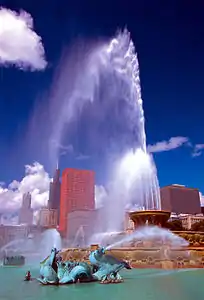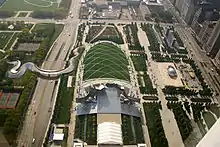 | |
| Agency overview | |
|---|---|
| Formed | Consolidated in 1934 Predecessors founded in 1869 |
| Jurisdiction | Government of Chicago |
| Headquarters | 4830 S. Western Ave Chicago, Illinois |
| Annual budget | $385 million |
| Agency executive |
|
| Website | chicagoparkdistrict |

The Chicago Park District is one of the oldest and the largest park districts in the United States. As of 2016, there are over 600 parks included in the Chicago Park District as well as 27 beaches, 10 boat docking harbors, two botanic conservatories, a zoo, and 11 museums, along with one stadium. The Chicago Park District also has more than over 230 field houses, 78 public pools, and dozens of sports and recreational facilities, with year-round programming. It also owns and operates the lakefront stadium, Soldier Field, which the Chicago Bears and Chicago Fire FC lease. The district is an independent taxing authority as defined by Illinois State Statute and is considered a separate (or "sister") agency of the City of Chicago.[1] The district's headquarters are located in the Brighton Park neighborhood.
Jurisdiction

The Chicago Park District oversees more than 600 parks with over 8,800 acres (3,600 ha) of municipal parkland as well as 27 beaches, 78 pools, 11 museums, two world-class conservatories, 16 historic lagoons and 10 bird and wildlife gardens that are found within the city limits.[2] A number of these are tourist destinations, most notably Lincoln Park, Chicago's largest park which has over 20 million visitors each year, second only to Central Park in New York City.[3] With 10 lakefront harbors located within a number of parks along the lakefront, the Chicago Park District is also the nation's largest municipal harbor system.
A number of Chicago Park District parks are located in the vicinity of or even adjacent to a number of Chicago Public Schools. This design was done in order to make it easier for public school students and faculty to incorporate school assignments or physical activities into the learning experience. Additionally, a number of Chicago Public Library locations are sited within Chicago Park District facilities.
The Chicago Park District is governed by a board of seven (7) non-salaried Commissioners who are appointed by the Mayor of the City of Chicago with the approval of the Chicago City Council.[4]
Notable parks
- Burnham Park - 598 acres (242 ha); runs along the Lakefront for much of the South Side connecting Jackson Park with Grant Park
- Calumet Park - 200 acres (81 ha); shares a border with the State of Indiana, and is also located on the lake.
- Columbus Park - 144 acres (58 ha); on the far west side of Chicago, considered one of the 150 Great Places in Illinois
- Douglass (Anna and Frederick) Park - 173 acres (70 ha) and named after Frederick Douglass and his wife Anna Murray Douglass, it is Southwest of downtown.
- Garfield Park - 185 acres (75 ha); this west side park contains a grand conservatory and lagoon
- Grant Park - 319 acres (129 ha); located near The Loop; Home to Buckingham Fountain, this downtown park is also a favorite site of major festivals including the Taste of Chicago, Chicago Blues Festival, Chicago Jazz Festival, Lollapolooza and others.
- Humboldt Park - 207 acres (84 ha) on the west side, was once a cultural center of Chicago's Puerto Rican Community and the site of a famous rally by pianist and statesman Ignace Paderewski that led to Poland regaining its independence after the First World War.
- Jackson Park - 500 acres (200 ha); located on the south side of the city on Lake Michigan, this park is famous for its role in the 1893 World's Columbian Exposition.
- Lincoln Park - 1,200 acres (490 ha); Chicago's largest city park. Located north of The Loop, this is one of the more distinctive parks in terms of geography, because while it is centrally located in the Lincoln Park community area it spans many different neighborhoods throughout the north side as it is nestled between Lake Shore Drive and Lake Michigan.
- Marquette Park - 300 acres (120 ha); the largest park in southwest Chicago, it has a golf course and many other attractions
- Millennium Park - 24.5 acres (9.9 ha); Chicago's newest marquee park, opened in 2004, just north of the Art Institute of Chicago in Grant Park.
- Washington Park - 372 acres (151 ha); located on the south side, it was the proposed location for the 2016 Summer Olympics Stadium.
History
In the 1860s, Chicago already had about 40 small parks, but no central plan, and it fell far short when compared to other major cities in the country. Lincoln Park was Chicago's first large park, created in 1860. Dr. John H. Rauch MD, who was a member of the Chicago Board of Health and later a president of the Illinois State Board of Health, played a key role in establishing Lincoln Park by persuading city officials to close several festering cemeteries filled with shallow graves of victims of infectious epidemics. Rauch next formulated a central plan for parks across the entire city, noting that they were "the lungs of the city", and pointing out that Chicago's parks were inferior to those in New York's Central Park, Baltimore's Druid Hill Park, and Philadelphia's Fairmount Park. His influence was key in setting up Chicago's modern park system.[5]
The current Chicago Park District was created in 1934 by the Illinois Legislature under the Park Consolidation Act (70 ILCS 1505 et seq).[6] By provisions of that act, the Chicago Park District consolidated and superseded the then-existing 22 separate park districts in Chicago, the largest three of which were the Lincoln Park, West Park, and South Park Districts, all of which had been established in 1869. In the late 1960s, the district lent its support for a Special Olympics for developmental challenged children. The Park District co-sponsored the first Special Olympics at Soldier Field in 1968.[7]
In the past several years, the Park District has initiated a program of renovating and beautifying existing parks and playgrounds, as well as initiating the building of a number of new parks, including Ping Tom Memorial Park, Ellis Park, DuSable Park, Maggie Daley Park and others. The Chicago Park District has also expanded programming in neighborhood parks throughout the city, and created a lakefront concert venue on Northerly Island on the site of the former Meigs Field airport. In 2014, the district won the National Gold Medal Award for Excellence in Parks and Recreation.[8]
Museums in the Park
Park District land hosts 11 museums in locations around the city. They are:
- Adler Planetarium
- Art Institute of Chicago
- Chicago History Museum
- DuSable Museum of African American History
- The Field Museum
- John G. Shedd Aquarium
- National Museum of Mexican Art
- National Museum of Puerto Rican Arts and Culture
- Museum of Science and Industry
- Museum of Contemporary Art
- Peggy Notebaert Nature Museum[9]
In addition, the district's parks host the free admission Lincoln Park zoological park,[10] the Garfield Park Conservatory,[11] and the Lincoln Park Conservatory.[12]
Government
The Chicago Park District's seven Commissioners govern the district. Under the Chicago Park District code, the Commissioners have a fiduciary duty to act, vote on all matters, and govern the Park District in the best interest of the Park District.[13] The Commissioners appoint the General Superintendent & Chief Executive Officer. On May 11, 2022, Rosa Escareño was appointed to the position.[14]
Lifeguard Service
The Chicago Lifeguard Service, or the Chicago Park District Beaches and Pools Unit, employs over 1000 as aquatics staff during the summer and 300 year round to protect the lives of patrons. Lifeguards are stationed at 23 beaches on Lake Michigan plus one inland beach, as well as, 26 indoor and 51 outdoor pools at city parks and 15 pools in public schools.[15] The Service is the largest municipal lifeguard force in the world and is regularly observed by representatives from Japan, Australia, Ireland, Germany, California, Florida and other locales. The Service also covers more waterfront than any other individual lifeguard force in the world; Chicago beaches cover over 26 miles of the lakefront.[16]
Image gallery
 Buckingham Fountain, Grant Park
Buckingham Fountain, Grant Park Flagstone steps in Portage Park
Flagstone steps in Portage Park Osaka Japanese Garden in Jackson Park
Osaka Japanese Garden in Jackson Park Lincoln Park Zoo
Lincoln Park Zoo Lincoln Park in winter
Lincoln Park in winter Millennium Park
Millennium Park Montrose Beach
Montrose Beach Oak Street Beach
Oak Street Beach
See also
References
- ↑ Chicago Park District. "General Superintendent & Chief Executive Officer". chicagoparkdistrict.com. Archived from the original on 14 December 2013. Retrieved 29 March 2016.
- ↑ "About the Chicago Park District". Chicago Park District. Retrieved 16 November 2012.
- ↑ "City Park Facts". The Trust for Public Land, Center for City Park Excellence. June 2006. Archived from the original on 2007-02-21. Retrieved 2006-07-19.
- ↑ "About the Board of Commissioners | Chicago Park District".
- ↑ William K. Beatty (1991) "John H. Rauch - Public Health, Parks, and Politics" Proceedings of the Institute of Medicine of Chicago Vol. 44 pp. 97-118
- ↑ "70 ILCS 1505/ Chicago Park District Act".
- ↑ "Flashback: 50 Years of Special Olympics". Chicago Tribune. July 15, 2018. Section 1; p. 23.
- ↑ "Chicago Park District Wins Gold Medal Award from National Parks Groups". DNAinfo Chicago. Archived from the original on 10 January 2017. Retrieved 29 March 2016.
- ↑ "Museums In the Park: About Us". Archived from the original on 2013-06-16. Retrieved 2013-05-27.
- ↑ "Lincoln Park Zoo". Chicago Park District. Retrieved 2018-09-19.
- ↑ "Garfield Park Conservatory – Garfield Park Conservatory Alliance". garfieldconservatory.org. Retrieved 2018-09-22.
- ↑ "Lincoln Park Conservancy - Conservatory & Gardens". lincolnparkconservancy.org. Retrieved 2018-09-22.
- ↑ "Chicago Park District Code | Chicago Park District".
- ↑ "Chicago Park District Board appoints Rosa Escareño as permanent CEO". 11 May 2022.
- ↑ "Chicago Park District - Aquatics". Chicago Park District. Archived from the original on 30 August 2017. Retrieved 18 October 2017.
- ↑ "Chicago Beaches | Home". cpdbeaches.com. Retrieved 30 August 2017.